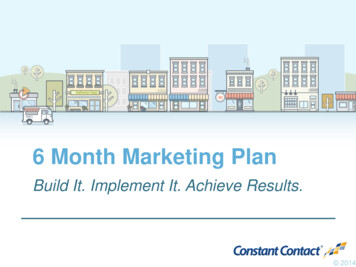
Transcription
What's Your Exit StrategyandDo You Need One?Norris C. Middleton, President/CEOManagement Support Technology, Inc. (MSTI)Michael C. Sawyers, Former President/CEO 7Delta, Inc.2
Objectives of SessionI.Session addresses the key aspects of a comprehensive plan for the future that focuses on:I.Customers/contractsII.III.IV.II.As a result of attending this session, you will be able to:I.II.III.III.Process and Infrastructure ImprovementLearning and GrowingFinance and ProfitabilityAssess where your business/program is todayWhat is the identified next level of successWhat it takes to get thereThis session positions you to:I.Describe the company visionII.III.IV.V.Mission and core valuesDefine the strategic goals and operational objectivesCommunicate the key performance indicatorsMonitor progress and accomplishments3
What’s your Vision?4
An Exit Strategy: What You Need To Know And Why A business’ exit strategy is the method by which a Business Ownerplans to leave the business or close the business. As a Startup owner – Why think about an Exit strategy? Examples of Exit Strategies - going public, selling your company toyour employees, business partners, or to the highest bidder, or retiringand handing over your business legacy to your family. Each case willrequire lots of different planning, legal and financial advice. You mayalso need to develop a succession plan.5
An Exit Strategy: What You Need To Know And Why(cont.) An Exit Strategy will take time and may evolve over time. But you needto start in one direction and adjust course as necessary.Thought Questions? 5 years from now, what does success look like to you? What trophy do we want on your mantle? How do you know today if you have been successful? If energy and resources were free, what would we do differently in your business? What are the implications of this decision 10 minutes, 10 months, and 10 yearsfrom now? Do we have the right people on the bus6
Business Plan vs. Strategic Plan A Business Plan and a Strategic Plan are similar but different. A Business Pan is usually developed at the start of a business and required byinvestors, lenders and certain agencies for certifications. It can also be used toimplement business unit plans to support the larger corporate strategic plan. A Business Plan describes the “who” and “what” of the business. The Strategic Plan describes the “how” and “when.” The Business Plan explains – Who is running the business, their qualifications, their experience and value– Who is the competition, what products or services they offer and your differentiators– Who is your customer, how large is your market, where they are located, what products andservices they need and how you will provide the required products/services to them7
Business Plan vs. Strategic Plan (cont.) The Strategic Plan describes :– How will you measure success? What metrics are important and how will you track them?– What actions do you need to take so you can achieve your goals?– What resources do you need to get there? Personnel, cash, equipment, training, Informationsystems, etc.– When will each action occur, who will do it, and when do you need to reach specific milestones? The Strategic Plan is the roadmap for your business– It identifies goals and objectives, tasks, milestones, and steps needed to move the business towardsyour vision. The strategic plan is used to move the businesses from where they are now to wherethey want to go in 3 to 5 years. The plan may be broken out into quarters and annual benchmarks.“A Strategic Plan is updated annually and used to provide focus, direction, priorities and actionin order to move organizations from where they are to where they want to be”8
Managing Your Business and Strategic PlanningI. Strategic Plan - A strategic plan is a high-level overview of the entirebusiness, its vision, objectives, and value. The crucial components of astrategic plan are:I. Vision - Where does the organization want to be 3 – 5 years from now?II. Mission - The mission statement is a more realistic overview of the company’s goals andobjectivesIII.Values – What is your company culture, what are you passionate about, what do you expecteach employee to perform, what are your ethics9
Managing Your Business and Strategic Planning (cont.)II. Tactical Plan - The tactical plan describes the tactics the organizationplans to use to achieve the goals and objectives outlined in thestrategic plan.I. Specific Goals with Fixed DeadlinesII. Budgets - The tactical plan should list budgetary requirements to achieve the aims specified inthe strategic plan.III.Resources - The tactical plan should list all the resources you require to achieve theorganization’s goals and objectives. This should include human resources, cash resources,personnel and financial systems, etc.IV.Marketing, Funding, etc. - Finally, the tactical plan should list the organization’s immediatemarketing, sourcing, funding, manufacturing, retailing, and PR strategy.10
Managing Your Business and Strategic Planning (cont.)III. Operational Plan - describes the day to day running of the company.The operational plan develops tasks to achieve the tactical goalswithin a realistic timeframe and focuses on short-term objectives.IV. Recommend that you develop, document and implement strategic,operational, tactical and financial plans using the S.M.A.R.T. acronym(Specific, Measurable, Attainable, Realistic and Timely) goals.11
Managing Your Business and Strategic Planning (cont.)V. Recommend that you establish corporate Key Performance Indicatorsand link everyone’s annual appraisals to achieving the corporateannual goal and objectives.12
Managing Your Business and Strategic Planning (cont.)13
Summary – Key Points Begin with the End in Mind– Have a clear Vision of where you are going, what type of companyyou want to be, and what you will do when you have achieved yourgoals or that the time comes for you to Exit.– Have an Exit Plan for investors or partners that want to leave beforeyou are ready to Exit. Have a written agreement for this process andvaluating the company in a fair and equitable way.14
Summary – Key Points (cont.) Review your Strategic Plan on a regular basis to mark your progress Provide the necessary resources for achieving your goals, involve yourpartners and employees at all levels in your planning and hold themaccountable for achieving your goals and objective, be transparent and keepthem informed of the business progress towards those goals Seek the sage advice of mentors and peers – there are many roads tosuccess, follow yours and if it doesn’t exist, make one!15
Summary – Key Points (cont.) Don’t try to do everything yourself! You may be good at many things, butnot everything! Hire people who are smarter or better than you in critical areasof the business. It’s OK, you’re still the boss! Look for folks who share yourvalues and business goals. Create a well rounded team. Consider giving up equity in the company for the right partner(s) who canshare the work load and risks. Consider a merger with another small companythat is similar to yours or adds additional strengths and capabilities. Considerone of the mentor protégé programs, formal or informal.16
Summary – Key Points (cont.) As the owner of your company, you are the leader and role model for your employees. Youset the Vision, the Culture and the Standard for what it means to be part of your business. Ifyou are not sure of your Vision and convictions then neither will your employees. Make sure your employees know that you appreciate their contributions and the sacrificesthat they and their families make in growing the business. In many cases, they are the faceof your company and may be the only ones the customer knows when they think of yourcompany’s name. Everyone in the company is important to a well run company, no matterwhat their role, from the receptionist to the President, and you need tell them so. They areyour front line! When your business is doing well make sure to share the success with your employees viaawards, appraisals, promotions, social events, etc.17
Summary – Key Points (cont.) Think About It: Put yourself in the shoes of an investor, a venture capitalist,or a larger company looking to acquire your company - OR your Employees whomight be considering a buyout - OR a family member who will take over if youexit due to health reasons or are just retiring to enjoy the fruits of your labor –the following is the question that must be considered: WHAT WOULD THEY BE LOOKING FOR IN YOUR BUSINESS: Perhaps profitability, great employees with experience and proven successrecord, clean accounting system, backlog of work, low turnover, smallindebtedness, good cash flow, good credit, great customersatisfaction, etc.18
Summary – Key Points (cont.) So don’t make your primary focus your Exit strategy but take it intoconsideration as you plan for the future. When the time is right, you willknow it! Bottom Line - Remember, the things you need to do to stay in business andbuild value in your business are the same things you need to do if you intend toExit/sell your business.19
References “Planning in Management: Strategic, Tactical, and Operational Plans,” JUNE 25, 2013 byKasia Mikoluk “An Exit Strategy: What Startup Founders Need to Know,” by Chris Ciko, School forStartups Business Mentor, 10 FEB 2014 “Startup Exit Strategy: Plan for the Unexpected Term Sheet” by Michel Courtoy, BoardMember, Breker Verification Systems, 12/5/2014 03:50 PM EST Starting & Managing a Business - tarting-managing-business “An Exit Strategy: What Startup Founders Need to Know,” by Chris Ciko, School forStartups Business Mentor, 10 FEB 201420
Resources - Recommendations The E-Myth Revisited: Why Most Small Businesses Don't Work and What toDo About It, Paperback – October 14, 2004 by Michael E. Gerber (Author) –“Gerber draws the vital, often overlooked distinction between working on yourbusiness and working in your business.” The Veteran Institute for Procurement (VIP) is the country’s first-ever program totrain veteran service-disabled and veteran owned small businesses to succeed in thefederal contracting market. The Maryland Montgomery County Chamber CommunityFoundation funds this three-day, 27-hour comprehensive training through partners,VIP Sponsors, and is offered at no cost to veteran businesses admitted to VIP.– VIP is aimed at veterans who are senior, “C-level” executives of small businesses withabout three employees and at least two years in operation. See more uf21
Resources – Recommendations (cont.) Starting and Managing a Business - Small Business Administration starting-managingbusiness/starting-business SCORE Association was previously known as the Service Corps of RetiredExecutives - SCORE is a nonprofit association dedicated to helping smallbusinesses get off the ground, grow and achieve their goals through education andmentorship. They have been doing this for over fifty years. Because their work issupported by the U.S. Small Business Administration (SBA), and thanks to theirnetwork of 11,000 volunteers, they are able to deliver their services at no charge orat very low cost - https://www.score.org/ The Minority Business Development Agency (MBDA) - http://www.mbda.gov/ International Trade Administration - http://trade.gov/22
Session EvaluationsReminderPlease complete the Speaker/Session Evaluation Form located in yourprogram guide and place the form in the basket in the back of the room.23
Questions?Contact Information Norris C. Middleton– President/CEO, Management Support Technology, Inc. (MSTI)– Email: nmiddleton@msti-net.com, Tele: (703) 385-5841 , ext.330, Website: www.msti-net.com Michael C. Sawyers– Former President/CEO 7Delta, Inc.– Email: mike.sawyers@gmail.com– Tele: (301) 221-238624
An Exit Strategy: What You Need To Know And Why A business’ exit strategy is the method by which a Business Owner plans to leave the business or close the business. As a Startup owner – Why think about an Exit strategy? Examples of Exit Strategies - going public, selling your company to your employees,










